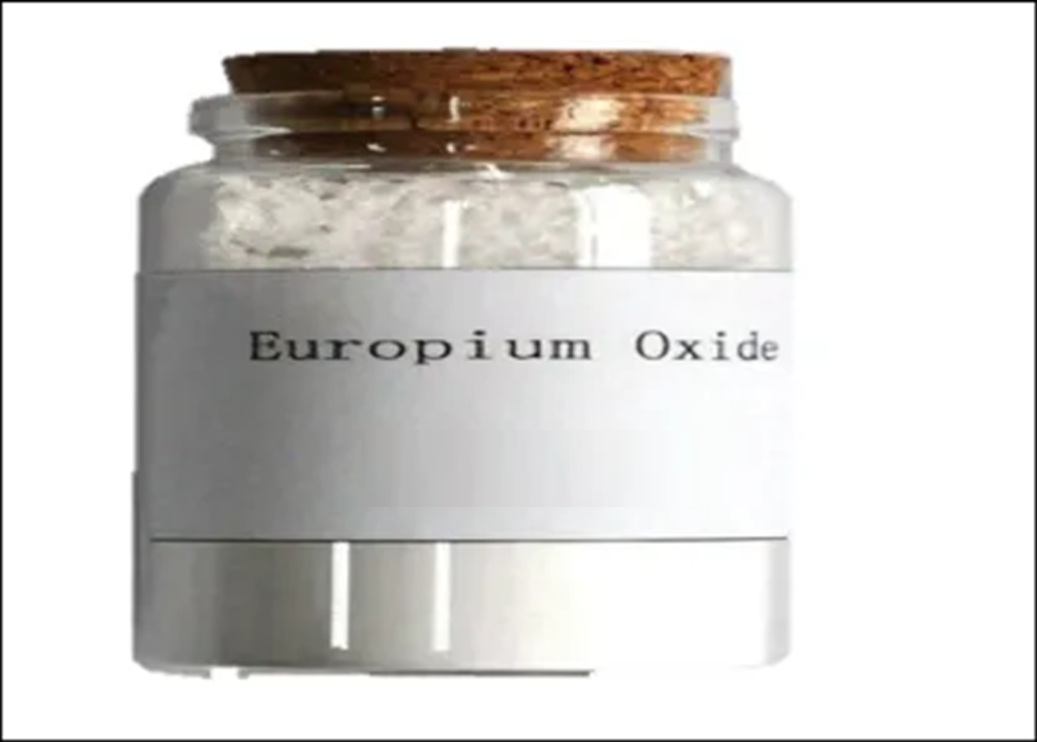We unleash your business potential by maximize the business innovation.
Send EmailEuropium Oxide, Europium Sesquioxide, Europia, 1308-96-9
Europium(III) oxide overview
Europium(III) oxide (Eu₂O₃) is a high-value rare earth oxide prized for its role as the standard red-emitting dopant in modern phosphors. It combines thermal stability with well-defined optical transitions of Eu³⁺, making it essential in lighting, display technologies, and specialty optics.
Chemical identity
-
Chemical name: Europium(III) oxide
-
Formula: Eu₂O₃
-
Molecular weight: 351.93 g/mol
-
CAS number: 1308-96-9
-
EC number: 215-164-2
-
Appearance: Pinkish-white powder
-
Crystal structure: Cubic and monoclinic polymorphs (phase depends on synthesis/thermal history)
-
Density: ~7.4 g/cm³
-
Melting point: ~2,350 °C
-
Solubility: Insoluble in water; dissolves in strong acids to form Eu(III) salts
Physical and chemical characteristics
-
Optical behavior: Eu³⁺ exhibits sharp f–f transitions; dominant red emission (~611 nm, ⁵D₀ → ⁷F₂) in suitable hosts, with high color purity.
-
Magnetic behavior: Weakly paramagnetic.
-
Thermal stability: High melting point and phase stability for use in high-temperature processes.
-
Chemical reactivity: Stable in air; converts to europium salts (e.g., nitrates, chlorides) upon acid treatment.
-
Particle engineering: Available from nano to micronized grades; morphology and surface area tailored for dispersion and sintering.
Production and grades
-
Feedstocks: Rare earth concentrates (e.g., bastnäsite, monazite) after REE separation.
-
Typical route: Acid leaching → solvent extraction/ion exchange → precipitation (hydroxide/carbonate) → calcination to Eu₂O₃ → milling/classification.
-
Purity grades:
-
Technical: 99.9% (3N) for ceramics/general use
-
High-purity: 99.99–99.999% (4N–5N) for phosphors, LEDs, and advanced optics
-
-
Forms: Nano-grade, submicron, micronized powders; agglomerate-controlled, low-chloride/sulfate variants for electronic applications.
Applications and mechanisms
-
Phosphors and displays:
-
Red phosphors: Eu₂O₃ is the principal Eu³⁺ source to dope host lattices (e.g., Y₂O₃:Eu, oxynitrides), delivering vivid red emission for LEDs, fluorescent lamps, and display screens.
-
Color calibration: High chromatic purity and stability under operating temperatures.
-
-
Optical materials:
-
Specialty glasses/ceramics: Improves luminescent properties; used where controlled red emission or upconversion is required.
-
Laser/host precursors: Eu-doped hosts for research-grade lasers and sensing.
-
-
Electronics:
-
Luminescent devices and sensors: Eu³⁺ transitions enable robust optical markers; used in anti-counterfeiting pigments and sensing films.
-
Semiconductor research: As a dopant or interfacial layer in niche thin-film systems.
-
-
Ceramics and pigments:
-
Color additives: Pink/red hues in ceramics and enamels; stable coloration under firing.
-
-
Nuclear and materials science:
-
Isotopic properties: Europium isotopes have notable neutron cross-sections; oxide form is more a precursor than a direct absorber in reactors.
-
Procurement specifications (ERP-ready)
-
Purity: 3N/4N/5N with declared total REE and trace metals (Fe, Si, Ca, Al, Na, Pb, Cu).
-
Particle size distribution: D10/D50/D90; sieve residue; agglomerate level.
-
BET surface area: Critical for phosphor blending and sintering behavior.
-
Loss on ignition (LOI): Indicates hydroxide/carbonate residues and adsorbed moisture.
-
Phase purity: XRD-confirmed Eu₂O₃; absence of oxychlorides/oxynitrides unless specified.
-
Residual anions: Low chloride/sulfate for electronic/optical applications.
-
Color and whiteness: L, a, b* reporting for consistency in pigments/phosphors.
-
Packaging: Moisture-barrier, antistatic for nano grades; batch/lot traceability.
Safety, handling, and storage
-
Toxicity: Low acute toxicity; fine powders may irritate eyes/respiratory tract.
-
Protective equipment: Gloves, safety glasses, and suitable dust masks (FFP2/FFP3 for nano/submicron powders).
-
Storage: Keep dry, sealed; avoid humidity to minimize surface hydroxylation and agglomeration.
-
Waste: Dispose of rare earth oxides per local regulations; avoid release to water systems.
Synonyms
-
Europium Oxide
-
Europium(III) Oxide
-
Europium Sesquioxide
-
Europia
-
Eu₂O₃
